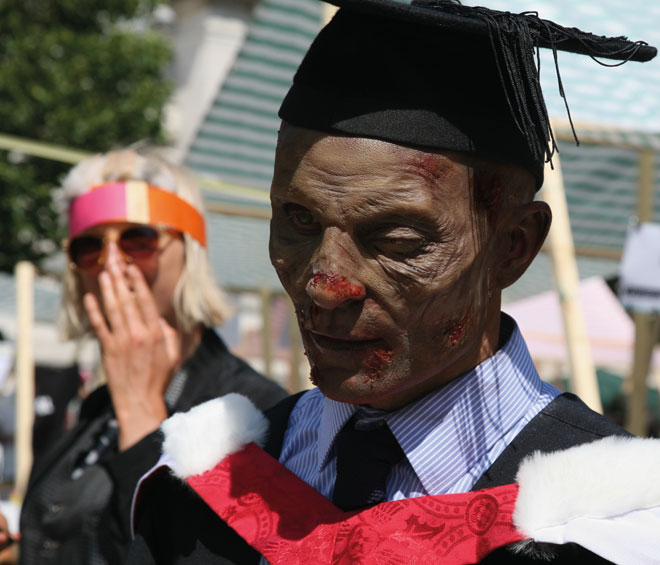
by MK PALOMAR
David Cross gave up air travel in 2005 to explore the possibilities of living a modern life within ecological limits; neither does he have a mobile phone. This might suggest he is a slow, ponderous person, the type who wears open-toed sandals and gets lost in his own vegetable patch, but this is not quite the case. “Be sure to drink enough coffee,” a colleague cautioned me when he heard I was interviewing him. Cross doesn’t often drink coffee – which is probably just as well, as his train of thought moves restlessly around a tapestry of complex thinking laced with unexpected connections. On his engagement with the contested idea of sustainable development and his passionate concern for the environment, Cross is clear as a bell. When I met him in his spotless, gadget-free apartment in south London, he talked about his past collaboration with Matthew Cornford, his artist placement at the University of the Arts London, his concern with the endangered conditions of university education, and the set of works he is developing now, each related to the destruction of our environment by fossil fuels.
MK Palomar: Am I right in thinking that there was a point when you gave up owning motorised vehicles? Can you tell us when it was that you began to alter how you lived your life?
David Cross: When I went to art school – I gave up a series of things, including my car and my motorbike.
MKP: Why did you give up your motorbike?
DC: I thought it was time to stop that way of life, haring around in a leather jacket, smoking, eating red meat, and drinking too much.
MKP: Were you having fun?
DC: Loads of fun! [laughs]. So, all that had to stop. I thought, right – I’m going to go to art school and live on a boat. In Yalding, a lovely village upstream of Maidstone in Kent, I lived on this wooden boat, with no heating, and very few visitors in winter. Mobile phones weren’t invented then. But later on, I had a mobile phone for a while.
MKP: Why did you have a mobile phone?
DC: I thought, this is more than convenient – it’s an exciting, professional thing to do. I can see myself now, strutting around organising art projects, issuing commands like: “Bring the helicopter over …” But then I realised life would be simpler without it and, besides, I wanted to conduct an experiment. I had a hunch that the mobile phone was going to change the way people relate to each other. I didn’t know how, but I thought, if I stop, I’ll see what happens. I’ve watched as people have come to communicate differently in so many ways – not just that with the emergence of Instagram they stopped sending postcards, but how they speak to each other and even how they make eye contact.
MKP: So how has your behaviour changed in relation to everybody else having changed and you not?
DC: Well, I’m a pariah obviously! [laughs]. The thing I’m really struggling with is air travel – I gave up a car, a motorbike, a mobile phone, credit card and television.
MKP: You gave up a credit card? Have you got a bank account?
DC: Yes – I use a laptop and I use a debit card, but I don’t willingly take on debt. If I don’t have money, I don’t buy something.
MKP: You’re clearly an unusual person living an unusual type of life. You’re a reader in art and design at the University of the Arts London. Can you tell us what that means? What do you do?
DC: It means a double life, as an artist and academic. The artist lives a kind of transversal existence moving intuitively between different interests and issues and forms of relationship, whereas the academic has to exercise rigour and precision in PhD supervision, monitoring procedures and upholding academic standards. But as a large institution changing under political pressure, the university is entering contradictions that call for as much flexibility as rigour.
MKP: Your university online profile says that, in 2012, in homage to the Artist Placement Group (APG), you designated your employment at UAL as an artist’s placement. Can you tell us why you did this, and is it a form of performance?
DC: I was invited to host a discussion about education, at Raven Row gallery in autumn 2012. I was (and still am) outraged by the unfair loading of debt on to students, and troubled about the consequences for art education and learning as processes of self-actualisation.
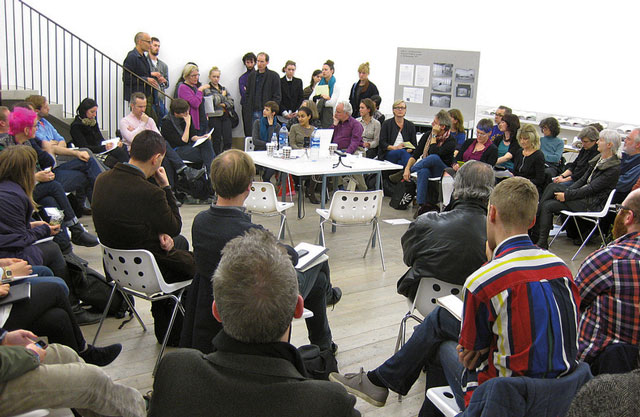
Education: Not Knowing, for ‘The Individual and the Organization: Artist Placement Group 1966–79’, Raven Row Gallery, London, 2012. Photograph: Neil Cummings.
In the gallery discussion, I said: “Here we are in an exhibition about the Artist Placement Group, to think about their relevance to our current condition.” Admiring Hayley Newman’s audacious self-appointment as artist in residence to the City of London, I asked: “What if we designated our jobs in universities as artists’ placements?” Rather than go as an artist to British Steel, or British Rail, or British Coal, or British Gas, or any other industry that has since been privatised, we could see ourselves as already placed in the cultural industry. There were a lot of blank faces in the room, but I thought, well, I’ll try it myself. As an artist on a placement, I gave myself licence to critically engage with the changes in my university, which as an employee I hadn’t felt free to do.
So, that helped me to confront certain issues and contradictions in the university, starting with its declarations of commitment to sustainability. I said if we really are wanting to be a sustainable university, then we should look at how our financial operations relate to our daily practices. I proposed to our senior executives that, to be sustainable in our operations as well as in the curriculum, we should switch banks away from the Royal Bank of Scotland and divest from fossil fuels. There was total silence – they just looked at me, astonished, as if to ask: “How could you, an academic, tell us how to run our university?” I began to think, maybe this isn’t your university any more than it’s my university – perhaps the “our” needs to be extended and the “we” needs to be interrogated. So, the unofficial placement started linking ecological issues to questions of finance, governance and ownership … Who does the university belong to?
MKP: You’ve changed costume.
DC: Yes, like Tommy Cooper changing hats.
MKP: And that gave you licence, you felt. Yet you just said a minute ago that you didn’t feel that, as an employee, you could tackle the university, and yet you are an employee …
DC: I know, [laughs] you’re right. After giving a lecture that linked RBS to extreme fossil fuels, weapons of mass destruction and human rights abuses in Sudan, I was warned not to indulge in “personal polemic”. In a way, it’s true – I do take it personally. I don’t believe in the split between who we are as people and what we do in our jobs.
MKP: And yet you’re splitting yourself between who you are as an employee and who you are as an artist placement person.
DC: By behaving as an artist while at work, I was trying to connect the different aspects of my being, as a way to turn the problem into a problematic, something that was up for discussion rather than buried below the surface.
MKP: Who told you to keep quiet? Was it a head of department?
DC: A senior executive called me into his office at 8am for a meeting without coffee and said: “Now, look here, there’s going to be a major restructuring and I wouldn’t want you to fall foul of it. I am advising you to cease and desist.” So, I shifted tack somewhat.
MKP: Do you care if you don’t have to work there any more?
DC: I do! I care enormously – I’ve devoted the whole of my adult life to higher education. Being creative and critical influences our sense of self and how we relate to each other. Going to art school, for me certainly, was a profoundly transformative experience: I got away from my home town with its assumptions and its restrictions and I was free to do whatever I wanted, which was kind of terrifying but beautiful. I love to see that, when young people come to art school and realise that they don’t simply have to answer a brief or do as they’re told. They can start to ask their own questions, make their own decisions, and learn from their own mistakes.
MKP: Yet you’re being told to do what you’re told.
DC: Yes, well … Perhaps by questioning the organisation itself, I came up against the limits of academic freedom.
MKP: Doesn’t it run up through the hierarchy – whoever is telling you how to behave is being told to tell you how to behave?
DC: I suppose there’s a degree of that, right up to the vice-chancellor operating within a policy framework set by the minister for education.
MKP: Do you tell the vice-chancellor how to behave?
DC: I have written to him a number of times saying that the reputation of our university is at risk if we carry on banking with RBS, and advising him to get UAL out of fossil fuels early. We could have been the first university in Britain to do it. This was years ago and he just ignored me, but I kept trying, giving presentations to official meetings of readers and professors, and meeting with the university directors … But it was only when I gave a lecture at Camberwell and a small group of BA students – most notably Georgia Brown – stepped up and said: “We’d like to do something about this,” that we started to get any traction.
MKP: So, it was the students who attracted attention really?
DC: Well, yes. We had discussions, in which the students were less interested in switching banks than in the more achievable goal of divesting from fossil fuels. So, I provided the research material and helped write the statements, and they launched a petition and staged a “die-in” at Central Saint Martins.
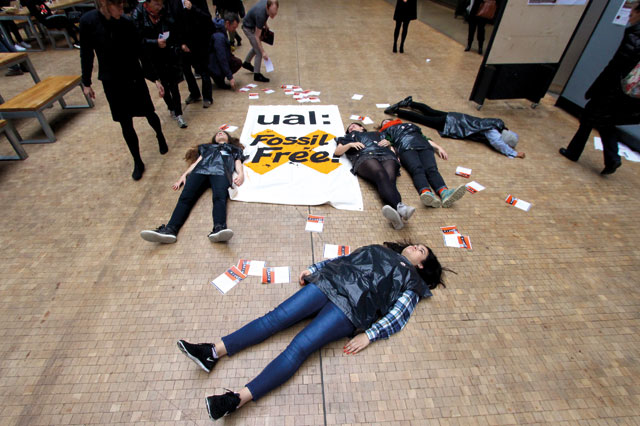
Divest UAL ‘Die-in’, Central Saint Martins College, London, 2015. Photograph: Georgia Brown.
Our collaboration led us on a journey, a struggle with the university, which in a small way we won.
MKP: Was this in 2015 when you did a performance called Master of the Universe?
DC: It was around that time, yes – I was a zombie, a zombie academic [laughs] at a public event called #TransActing: A Market of Values.
MK: And you got yourself made up as a zombie.
DC: I did. I had a facial prosthetic applied, and I dressed up in my MA Royal College of Art graduation cap and gown and stumbled around the Chelsea Parade Ground, looking like death …
MK: Your first performance?
DC: Yes, it was, the first and only one so far. I felt I needed to exorcise my demons.
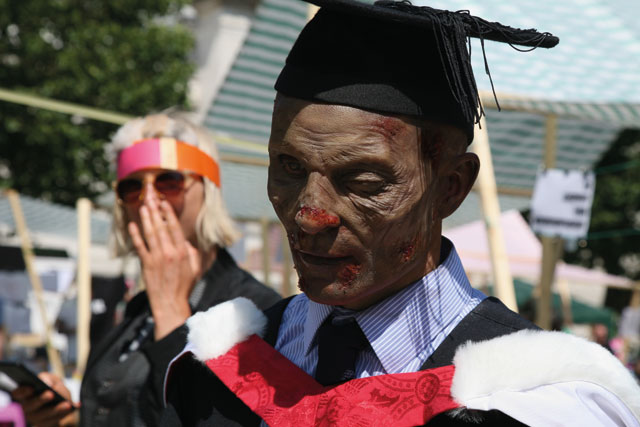
David Cross. Master of the Universe, 2015. Academic robe, theatrical makeup. Photograph: Karel Doing.
MKP: Did you speak dressed like that?
DC: No, I didn’t say a word, I just lurched and staggered about, bumping into people. It was fun, on a lovely summer’s day, to act out my dark fears about institutional capitulation and ecological collapse. If the university really does privatise itself, then I don’t know if I’ll have a part in it any more. So when I’ve lost every battle, and it’s no longer possible to collectively reclaim the university and orient it towards public service or the common good, then it’ll be time to go and do something else. And we’re getting quite close to it now.
MKP: Why do you think we’re getting close to it now, and what something else you would do?
DC: I think we’re reaching a point where, together, the debt taken on by the university to finance its major building projects and the debt imposed on students to pay tuition fees might overpower critical discussion, allowing illusions and contradictions to pass unquestioned. But if that really does happen, I’m not sure what else I can do, as I’ve been institutionalised for so long!
MKP: Can we go back to you and your research? You have said that your “research, practice and teaching have long been informed by a critical engagement with the relationship between visual culture and the contested ideal of ‘sustainable development’”. What do you mean by that, and can you explain it?
DC: Visual culture, for me, is an enormous shifting field that includes plasma-screen TVs and smartphones, as well as cinema and posters and book covers and vinyl LPs and, of course, contemporary fine art. It’s also not just the outcomes but the practices of coproduction and exchange of meaning through visual communication. And then the contested idea of sustainable development. [sighs] I’ve watched sustainable development since about 1985; my reason for coming to Saint Martins was to engage with environmental issues, and I thought that communication, art and design would be the way to reach people and get them to think differently about the planetary ecological crisis. I describe sustainable development as a contested ideal because it’s being torn back and forth, to the point where the term has almost collapsed. On the one hand, people are struggling to change their patterns of consumption or to redefine themselves as other than consumers altogether, and, on the other hand, very subtle and skilful marketing campaigns say: “We share your desire to reduce your impact, but don’t worry about politics, just make informed ethical choices as a ‘green consumer’. And that’s … [deep sigh] It has delayed progress by a good 30 years or more at a critical time while the energy crisis has accelerated and the climate crisis has locked in. The corporations have held us believing that we could save the planet as consumers, and it just isn’t true. A deeper transition is needed. I’ve been struggling with it since the mid-80s, but I can’t say that I’ve succeeded, so when you hear a little nervous laugh, you’ll know I’m thinking about ecological collapse.
MKP: How long do you think it will take?
DC: Well my colleague Matthew Cornford used to say it took the Roman empire 800 years to decline. But I’d say the Romans weren’t dependent on fossil fuels; their population was lower, the stocks of minerals were almost untouched, and the ecological buffers of forests and oceans and soil were undepleted by comparison with our times. Yes, they created the Sahara desert to an extent, but they didn’t wipe out whole swathes of species and the ecosystems that support them. We are a far bigger population moving around more, we’ve got nastier weapons and we are accelerating our ecological debt, rather than living in a steady state. So, my guess is that within a generation we’re going to hit really critical issues.
MKP: Now that you’ve given me that answer, I want to ask you, how can you manage to live with that stark reality so clear in your mind all the time?
DC: That’s such a lovely question. Um … I struggle, to be honest. I get very depressed sometimes. The world falls so far short of how I would like it to be that the gap is often intolerable. The only set of behaviours that allows me to live with that gap is creative practice. Art allows me to live with the world as it is, because I can at least try to achieve an awareness of how I relate to its beauty and complexity. So, yes – art is what fills the gap between how the world is and how I’d love it to be.
MKP: Let me go back to the beginning of your practice. You’ve been making work since the late 80s when you were a student at Central Saint Martins with Matthew Cornford, with whom you worked for around 25 years?
DC: It was, yes.
MKP: Can you talk about your creative process, collaboration, and how you progress from an idea to a completion?
DC: There are two interlocked questions there, one about collaboration and the other about creativity.
MKP: Can we start with collaboration because it’s very pertinent to you, I think.
DC: Yes, um … I began collaborating with Matthew when we were both students at Saint Martins, and he helped me to complete a piece of work just in time for a group crit. I think the idea I was trying to communicate was sound for that stage of the course, but I couldn’t physically produce it in the time …
MKP: Do you remember what the work was?
DC: Yes. It was a documentary photograph of a rightwing gathering, a procession of skinhead thugs, with a police officer marching proudly at their front, as though he were leading them rather than policing them. I wanted to superimpose this photograph on to the union jack, as a way of talking about subcultural identity in relation to political identity. (It was a crude, early piece of student work in my first year of a BA.) But I wasn’t sure how to cut the photograph – this was way before Photoshop – Matthew just came and helped, and within half an hour it was done. At that point, I didn’t even know his name.
MKP: Were you both new and this happened in the first month of you being at college?
DC: Yes, it was early in the first year, and I wasn’t aware of what a crit was, so being unready, I was nervous and feeling vulnerable, and here this total stranger came and helped me.
MKP: Why did he help you? Did you ask him?
DC: I did, and that’s what began our dialogue. I asked: “Why would you help when everyone is supposed to be out for themselves?” This was 1986 and the unspoken assumption was that creativity was all about individuality, not cooperation and sharing. And so, we began a discussion that lasted for 25 years, struggling back and forth asking, what is an individual, what is a relationship? Do we understand each other? Does the intersection of our different experiences and attitudes mean something? It was through making things happen in concrete situations that we tested these ideas. Each collaborative project was full of trouble and friction, as well as pleasure and achievement, and so it was an enormously enriching thing to do, as it forced me to question my beliefs and even unravelled my sense of self. Our collaboration was never stable; we were always contesting every opinion and assumption, which was very productive but exhausting. Open-ended critical discussion was a kind of professional position we took. But it was of personal interest as well, because I don’t see a clear division between the professionalist attitude to art, and the creative impulse that springs from the personality and life experience. So, that was our collaboration. For me, creativity comes out of a dissatisfaction; it isn’t simply the pleasure of making things. I might play a little, but I’m only driven to complete a project when I feel there’s some kind of shortfall in the world, or my approach to it.
MKP: Do you want to talk about the position you’re in now in terms of making work?
DC: Well, I was very upset when Matthew and I ceased to practise, because I didn’t understand his reasons for wanting to end it. I was stunned by the way he just broke off all contact, and I don’t understand it to this day. It’s three years ago now since we last spoke …
MKP: There wasn’t some kind of event that occurred or a piece of work that you didn’t agree on?
DC: Yes, there was actually – I don’t want to bore your readers with too much detail, but we would always work jointly on the conceptual aspect of a project and, then, to produce it we would often share out the workload, meeting up to check progress. Anyway, on one project he was working with a technical consultant, but it didn’t become evident for several months that that side of the project was going to fall through. When this person pulled out, I was left to pick up the pieces against a deadline for an exhibition, and I got short tempered and irritable to the point where my criticality triggered a dispute, which was a real shame because I think misunderstandings grew out of that.
.jpg)
Cornford & Cross. Black Narcissus, 2014. Artificial mountain landscape generated from financial graphs.
Anyway, I managed to complete the project in time, it was well received, nobody knew of our dispute, and I thought we could work it all out afterwards. Evidently, Matthew didn’t think that. Maybe a conversation will come up in time – I hope so.
But in the past six months or so, after 25 years of joint practice and three years of waiting, I’m excited about beginning again as an artist. I’m working on a series of projects that are not context-specific installations in public places, because there’s no more funding for that kind of thing, and I don’t want to try and repeat the kind of work we made jointly. I’m going back to “the problems of picturing”, as I want to test out some of my assumptions and practises around image-making, in relation to the issues which have driven me on this journey, from challenging the university to divest from fossil fuels to proposing that we imagine the university as a co-operative, owned and controlled by the staff and students … Which hasn’t gone down well in all parts of the university! [laughs].
MKP: I have a question related to that. In a text taken from, For and Against: Art Politics and the Pamphlet – a symposium you took part in last year at Loughborough (May 2017), it explains that you attempt “to engage staff and students in creative action to align the university’s operations with its values”. What do you think the University of the Arts London’s (UAL) values are – and how do you come to your assessment?
DC: Well, I was referring to the fact that, officially, the university says that its key aims are to become sustainable and to deliver transformative education. My understanding, as someone who benefited from a process of transformative learning, is that you can’t deliver transformative education. Education is not a product you pay for and consume, like a pizza. It’s a process of self-actualisation, which has to be transacted between people, in a setting, over time. I think that we realise who we are through our relationships, in the institutions that we produce and reproduce, with the resources we’ve inherited from previous generations. And we pass them on to the next, battered and worn perhaps, but much loved. So, I wanted to involve staff and students in asking: “If we really believe in sustainability, why are we banking with the Royal Bank of Scotland? At that time, RBS was heavily investing in extracting oil from the tar sands in Canada, the most ecologically destructive project on Earth. Why allow student fees to tear up the forests of the First Nation peoples, driving the wolves and bears to extinction, and poisoning the water? For fossil fuels that destroy the climate? But the answer to these questions was only silence. So, I realised that we had a fault line running through the university: between its public declarations and its actual material operations. And this fault line follows a division that is structured into the university: academics and students practise creative and critical thought, self-reflectively testing their assumptions and refining ideas, open and exposed to the scrutiny of their peers. But the people who now run the university as a business – estates and operations, financial managers, executives, consultants and so on – are not exposed to such scrutiny. They don’t have to explain themselves to a sceptical audience. They take their decisions more or less in private and announce them in briefings to the staff and students, who find that the university has been put in hundreds of millions of pounds of debt to an ecocidal bank, while wanting to believe that the university cares about sustainability. So, aligning the university’s stated principles and aims with its actions might be too ambitious, but I still think we could at least bring them a bit closer.
MKP: You talk about a fault line; surely that fault line comes from the government and the torn condition of our society today. Can you make a connection between those kind of fault lines and, for instance, technology and how we have become less able to communicate with each other? Is there a connection?
DC: I think so, yes. It’s not a linear connection, you couldn’t draw it like a diagram of a machine, it’s more like a web of nerve tissue, or a set of changing relations. But I do think that the enormous overload of information is putting a cognitive burden on people, which they can’t cope with, while maintaining empathetic affective relations. When I’m stuck on the laptop all day, I come away feeling dazed and inadequate at being unable to process such enormous amounts of information, and that doesn’t make me feel generous and open-hearted, it makes me feel weakened and insecure. So, I think that in our technological society people generally are overloaded, maybe academics more than most. Perhaps the surplus of information is part of the general over-production of things in the world.
MKP: Doesn’t being overloaded with information mean that in some way we are becoming more detached?
DC: Yes, but the detachment isn’t just a result of overload. The idea that the point of our creativity is to create value that can be captured as intellectual property is, I think, a tragic misunderstanding of the social relations that support creativity. If all we’re doing in the art school is learning transferable skills that we can sell in the creative industries and then spend the digital money on commodities [pauses], it’s a sterile vision of cultural practice. Employment may be necessary, but it’s not sufficient as a purpose for art school. But I wonder whether the fault line in the university isn’t only external: is it also in ourselves? I often feel torn between career success, and healthier social relations. So, I can understand that people who seek power and money and promotion and status might be absolutely caring, warm and kind with their friends and families at home, but when they put on a suit and go to work, they behave in ways in which they would never do in their personal lives. So, we internalise and perform the organisational structure, when we assume certain roles. That’s what makes it interesting – if it were simply a matter of adjusting a mechanism, it wouldn’t be a very absorbing problem.
MKP: It seems completely absorbing and immense, so, therefore, how do you step outside of that to make your own work, although as you explained earlier your artist placement in the university is your work, is your creative practice?
DC: Building on the fossil fuel divestment campaign, I’ve collaborated with colleagues, staff and students to organise events, such as Radical Rethink at the ICA in London. We brought academics and students together from Aberdeen, Amsterdam, Geneva and London, to discuss the crisis in art education. But it’s exhausting to keep bashing away in an antagonist engagement with such a vast and problematic trend. To recover, I need to step back, calm down, look at pictures, and consider what they might mean.
MKP: Pictures of what?
DC: Well, for example [holds up some sheets of paper full of diagrammatic notes that include algebra, thumbnail images and written text], these are notes for a work I’m planning about the Miners’ Strike in the 1980s, when aerial photography was used by the government to calculate the volume of coal held by the National Coal Board.

David Cross. Study for The Master and His Emissary, 2018. Pencil and ink on A4 paper.
Stereoscopic photographs were taken of the coal heaps, so the volume of coal could be calculated using geometry: to find the volume of a cone, you multiply the area of the base by the height of the cone and divide the product by three.
MKP: And that gave you the volume of your coal mountain?
DC: Geometry and photogrammetry would give a fair approximation, which would then have been combined with knowledge from geology to estimate the mass of the coal, and physics to estimate its thermal yield in a power station. Then, I imagine, meteorologists were consulted about the weather forecast, and engineers would have advised on the consequent range of demand for electricity.
MKP: And you’re also talking about the materials that are used to make things. So, there might be an argument about which is worse: oil or plastic? Which would you prefer your beach to be covered in, oil or plastic?
DC: [laughs] That’s a lovely, fiendish question, isn’t it? One of the liberating things that art can do is to reject the menu of choice that’s presented to us and propose different questions altogether. So, I would ask, how can we reach a steady state economy in which material resources were consumed no faster than they were renewed? I’d prefer that to choosing between oil or plastic on the beach! I don’t see clean oceans as a utopian fantasy. Cleaning up our mess is an enormous problem, but it’s not impossible.
The companion project I’m working on also interrogates how the view from above relates to the situation on the ground. Aerial photography was used to calculate the stock piles of coal, breaking the miners and capturing the energy industry in Britain as crucial first steps in a long class war. Now, having used the fossil fuel to power our consumerist lifestyle, we’re facing the ecological consequences of the melting of the ice caps. Scientists are using satellite remote sensing to study the thickness of the ice and calculate its depth, and it seems that each new refinement of the process reveals that the problem is worse than was previously thought and accelerating. As an artist, I’m interested in the whiteness of the ice and the blackness of the coal, how images can have both an indexical and a symbolic link to the world, and so how making pictures affects our understanding of what can be achieved.
MKP: Do you know how to make pictures now?
DC: I haven’t entirely forgotten – though my sketches look a bit scrappy!
MKP: No, I didn’t mean a criticism of your work, I was referencing back to the time that Matthew Cornford helped you to make a picture when you were at college.
DC: That’s a very good point. Maybe I misrepresented our collaboration, because although it did start with him helping me to complete a photomontage, our practice was to approach understanding by working on images together – and it was through a kind of agonistic exchange based on picture-making that we would reach agreement.
MKP: Was the process in any way related to aesthetics?
DC: Yes, I think so.
MKP: Because that’s such a personal thing
DC: It can be, although I’m also interested in how a concept such as proportion finds visual expression through geometry.
MKP: Are you a mathematician?
DC: No, not at all, I was hopeless at mathematics at school, until my tutor explained to me that it was a language, and then I became quite fluent at algebra for a while …
MKP: But you’re remembering it now in this work.
DC: Yes, exactly. I’m attracted to the geometric forms of the cube, the sphere and the cone as impossible ideals, whereas the infinitely regressing, unfolding of complexity in the world and the Earth might be better visualised through fractal geometry. Art seems to me the best way to approach the dynamic, turbulent systems that we are part of, as it allows me to relate my own perception to the thing that I’m studying.
As you were asking about pictures, maybe I should show you a couple of things which I have been looking at. [Cross walks over to his workspace where different images, postcards, books, Post-it notes and prints of landscapes, are arranged; we stand over a table spread with postcard images of aeroplanes]. I was telling you about my renunciations, one of which was to give up air travel many years ago …
MKP: But you haven’t renounced collecting postcards of aeroplanes. Do you love them?
DC: Sort of love and hate really. Matthew and I made Childhood’s End, which used an aerobatic jet aircraft to draw the anarchy symbol with smoke in the sky, and Trance Nation, which used a police helicopter to describe a logarithmic spiral in the airspace over Milton Keynes at dawn on midsummer’s day.
I get mixed feelings when looking at these airline postcards with their clean-looking aircraft flying free in beautiful skies. Having learned about the damage that air travel does to the atmosphere, I gave it up in 2005, and I wonder now if I did my career a great dis-benefit, without achieving anything of value?
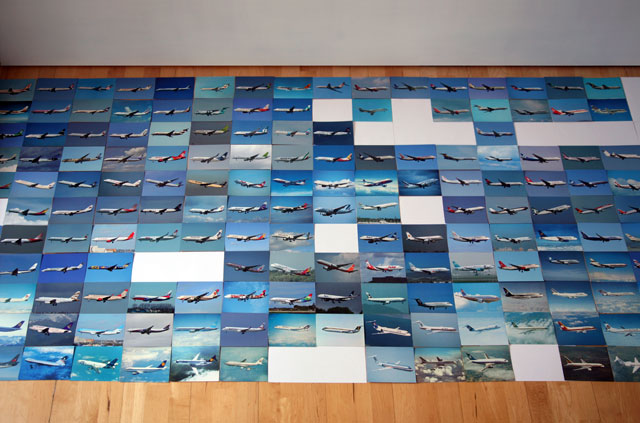
David Cross. Study for Les Droits De L’Homme et Du Citoyen, 2018. Airline postcards.
MKP: Do you allow yourself to travel by ship?
DC: Yes – though actually shipping’s pretty awful, too. They burn this awful heavy diesel and throw stuff overboard all the time.
MKP: Does that mean you have to travel everywhere by bicycle?
DC: My bike is tough enough for an expedition, so there’s no excuse – I just have to find the strength and courage! Meanwhile, I’m collecting and arranging my collection of airline postcards within this grid system.
Each card is A6 size, so sixty-four of the ones I have here make up to A0, which has a surface area of one square metre. I love the metric system as a practical expression of the ideal of universalism; it was refined and promulgated just after the French Revolution. From the north pole to the equator, the circumference of the Earth divided by ten million makes one metre. Such a beautiful thing, to support social agreement with a system of measurement based on the surface of the Earth. Metric makes a practical connection between the abstract and the concrete, which relates distance to mass: a ten centimetre cube of water at sea level is one kilogram; a cubic metre of water is one metric tonne. It’s such a wonderful system, so clear and simple. And yet we go tearing though the sky with jet aircraft putting out carbon dioxide and water vapour and affecting sea levels without taking account of how our actions are adding up to a problem that is so vast it’s incalculable. By arranging my collection of airline postcards, I want to play with the relationship between order and chaos, counterpointing the calm stability of the metric system with the endless unfolding of an unruly world.
MKP: How would you display this work? Would there be any text?
DC: I think there would have to be a text, really – I couldn’t resist having a one-page text on A4. For every Cornford & Cross project, we would write a brief text. Matthew often fought against it and he almost won with our last project, Afterimage, but I pretty much insisted, because although language can never encompass our physical actions, I don’t think pictures or objects speak for themselves.
MKP: You don’t believe pictures speak for themselves, that’s interesting. You’re marrying these different disciplines together – mathematics and environmentalism – and you’re also exposing the process by including the text, the text being the thinking behind the making, and there it is next to the image.
DC: I hope that the text doesn’t simply explain, that it brings in thoughts and associations that aren’t contained in image itself. Roland Barthes identified anchorage and relay as two functions of text in relation to the image. “Anchorage” is when the text fixes the viewer’s attention on a meaning that could reasonably be said to be contained in the image; “relay” is when a text brings in something that wouldn’t be seen by anybody looking at the image, so it’s a way of adding something to it. Literature is a part of my life, so I often associate the titles of books that I’ve been moved by with the work that I’m making. One work that I’d like to tell you about is titled after Bonjour Tristesse (Hello Sadness) by Françoise Sagan, a wonderful book written as postwar austerity gave way to the consumer society with its anticipation of material comfort and pleasure, before it became excess. So, when the world was at a crossroads, here was a young person who had failed her philosophy exam and was enjoying a summer of simple hedonism, thinking that she could intervene in the relationships around her, more or less innocently, but the result was tragedy. I’m wanting to associate that with a solar furnace at Odeillo, high up in the French Pyrenees. It’s a beautiful great modernist building with a vast concave mirror.
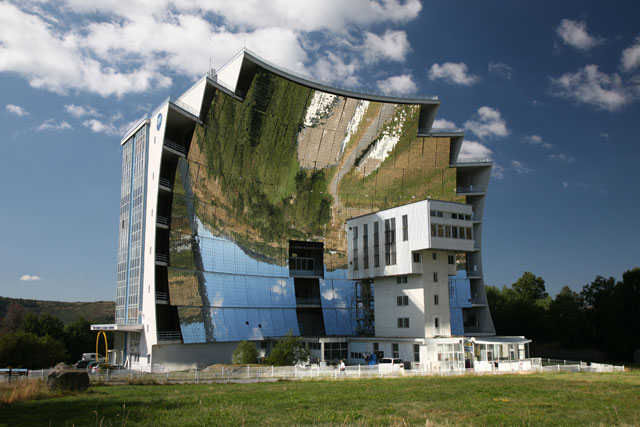
Félix Trombe Solar Furnace, Odeillo, France, 2010. Photograph: David Cross.
MKP: What’s it doing there?
DC: It’s a government-funded research centre that was built there in 1968, so it’s the 50th anniversary this year.
MKP: What’s it for?
DC: Scientific research into materials. By using mirrors to focus the image of the sun, they can produce temperatures hot enough to melt diamonds, they can fuse asbestos, they can test ceramics for aerospace applications. My project is to take a high-definition video camera there, and to set it up in the focal point facing the giant mirrors. As the sun rises, the rays would focus on the camera where it would witness and record its own extinction.
.jpg)
David Cross. Study for opening sequence of Bonjour Tristesse. Video camera destroyed in solar furnace.
MKP: And how would you get a record of that while it’s overheating?
DC: I’ve been waiting for years …
MKP: For technology to advance enough and wifi to get fast enough that it sends an image as it’s dying?
DC: Exactly! Beautifully put – that’s exactly it. I’m fascinated that an image can exist in the place and time of recording but also in a digital copy elsewhere. And besides, it’s a good excuse to go off to the mountains again.
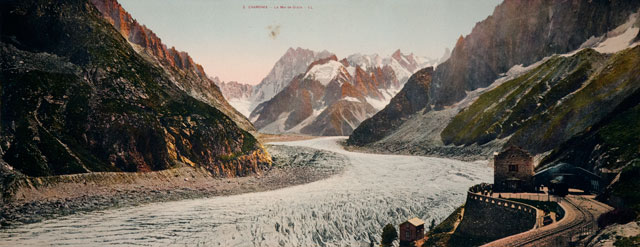
La Mer De Glace. Collotype print. Les Belles Éditions Françaises, Nice, c1900.
MKP: Do you spend a lot of time out there?
DC: I do, I’m fascinated by the mountains. This image from above Chamonix is a wide format photograph of La Mer de Glace (The Sea of Ice), a beautiful glacier, seen here around the turn of the last century. To one side of the image is a steam train on a tourist railway, so the journey to admire the ice involved burning fossil fuels. Like all the world’s glaciers, this glacier may soon be gone. But I want to take this faded photograph to a conservator in Camberwell, to see if we can preserve it, as a way into a dialogue about the relationship between preserving the image and preserving the thing that it depicts, which is impossible. So, a practical working through of a material task might release a sense of grief and loss, as a way of approaching this enormous open problem.
MKP: You said you’re working with a conservator in Camberwell. Is that Jocelyn Cuming (head of the conservation department at Camberwell College of Arts) you’re working with?
DC: Yes. Jocelyn’s a friend and colleague. She’s been so supportive and has agreed to either help me conserve this photograph or help me find a conservator who can. The conservation course at Camberwell is world famous, and I’m concerned that the course itself may not be conserved, if it isn’t seen to be marketable. But, hopefully, our interaction will draw attention to the importance and value of the work they do.
MKP: And once it is conserved, where will you take this image for maximum exposure?
DC: There’s the Alpine Club in London.
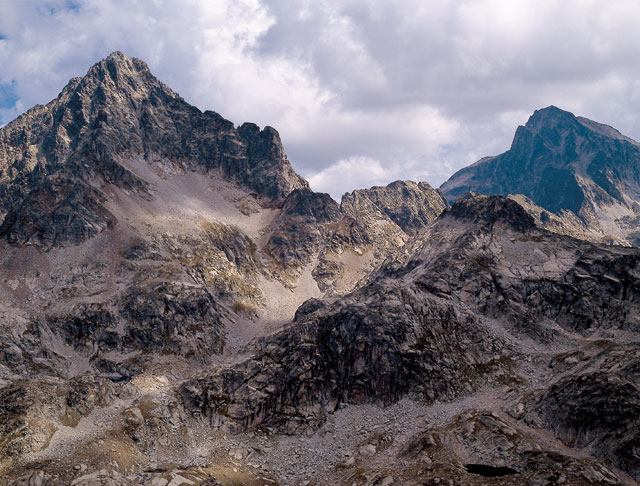
David Cross. South-Western Pyrenees, France, 1993. Medium format transparency.
MKP: Are you a member?
DC: No, I’ve never been a mountaineer, I’ve gone on long rambles in the mountains, but I’ve never been up with crampons and ice axe or anything of the sort. I look at mountains in a range of ways, but I don’t feel a desire to conquer them. Fortunately for me, getting up to the peak of Mont Blanc has been done; it was a magnificent achievement but it’s not my way. I just love to be in the environment with the silence and the clean air and I especially love seeing snow fall and snowmelt fill the rivers.
MKP: It’s again about your environmental concerns. Would you take it to the Royal Geographical Society?
DC: Good idea – thank you! This wouldn’t be a commission, but the result of an exploration …
MKP: About images and environment?
DC: Yes – I’m interested in the relationship between the power of fossil fuels, whether in a steam engine, a power station or a jet plane, and the resulting damage to the ecosystem. But the question for me is how images influence our view of the benefits of material comfort and pleasure, in relation to the problems and worries that are the unintended result.
MKP: Let me ask you about these other images up on the wall here. You have a number of images of Venice from different viewpoints, and then an exploding burning oil rig?
DC: Exactly; I was fascinated by the Deepwater Horizon, the British Petroleum oil rig that tragically exploded in April 2010 in the Gulf of Mexico, killing 11 people. The rig had carried out the deepest drill in the world; 1.5 kilometres beneath the sea bed, which surely signals that we’re running out of oil: as well as the climate crisis, we have the energy crisis – it’s taking so much energy and capital equipment now to get the last bits of fossil fuel that the net yield is heading for zero.
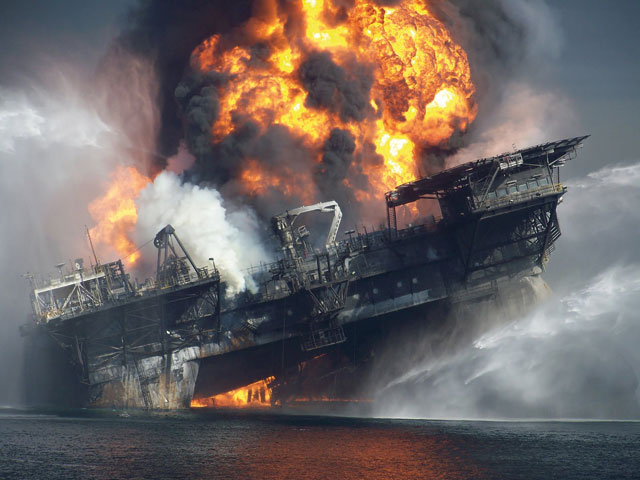
The British Petroleum Deepwater Horizon Oil Rig (April 2010). Photograph provided to The New York Times by a worker who asked not to be identified.
This photograph of the explosion was taken by an oil worker, before any news agency reached the site. It must have been taken from a boat as they pulled away from the sinking oil rig. The sky was filled with black oily smoke, and there are jets of water being fired at the sloping decks of this titanic structure as it goes down. It looks like a war photograph, or a disaster movie image, but it was taken at the scene not by a journalist or film-maker, but by a witness and participant. They anonymously donated the photograph to the New York Times, which wouldn’t put me in touch with them, or even tell me their name. After almost a year of searching, I eventually traced the photo through an educator in Florida who made it available to me under Creative Commons. Now, I have asked a successful artist who paints delightful landscapes – lush, finely observed paintings of the Norfolk coast with its open skies, and Venice, with its sunlight and rippling water – envisioning a world untroubled by climate change or oil pollution …
MKP: You’ve asked them to paint the image of the burning oil rig?
DC: Yes – what I am asking is, if we love beautiful landscapes for the escapism they might offer, can we face the threats to the places they depict? When I look at a beautiful painting of the Norfolk coast, or of Venice, I have in my mind a shadow of anxiety about rising sea levels. Depicting a disaster won’t undo it, much less prevent another, but maybe looking steadily somehow withdraws permission for the destruction to continue. So, hopefully, a collaboration with this painter will enable us to talk about what we gain from landscapes, and whether visual pleasure can support a more active engagement.
MKP: You have a book by Dan Flavin resting against the wall and a note next to it beside a double electrical point, one of the switches is on, the other is off. Is this significant?
DC: [laughs] I was thinking it might be …
MKP: And the note says: “No Gods! No Masters!”
DC: Well, I’m interested in the illusions sustained around energy from fossil fuel. For 15 or 20 years, we have been told that we can’t rely on renewable energy; to generate the electricity that keeps the lights on, we have to keep the coal fires burning. Through that time, I’ve admired Dan Flavin’s minimalist work dealing with light. I always saw Flavin as part of a golden moment of visual culture, a time when the industrial society was more sure of itself, and the doubts were far off in the future. Now we’re in that future, I want to take a Dan Flavin striplight, and power it with renewable energy from a co-operative. I’m imagining a conceptualist artwork that relates back to the minimalism that gave rise to it, and that the open system it’s part of should be socially and ecologically aligned. We don’t need a private fossil fuel corporation to keep the Dan Flavin lights on. I think we can have the luminous modernity that Flavin’s work embodies – the almost utopian optimism – without the dystopian nightmare of fossil fuel. “No Gods! No Masters!” is a slogan of anarchism and the labour movement, declaring a will to exercise freedom collectively. An energy revolution wouldn’t take us all the way there, but the possibility that we can free ourselves from destruction, isolation and enslavement is such a lovely idea, that I don’t see why we shouldn’t give it a go, really.
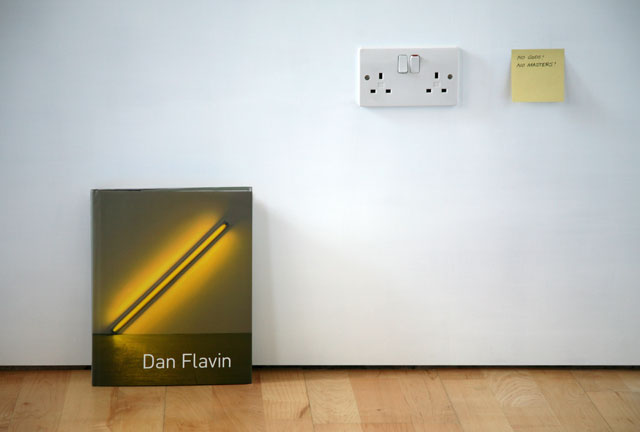
David Cross. Study for No Gods! No Masters! Digital photograph.